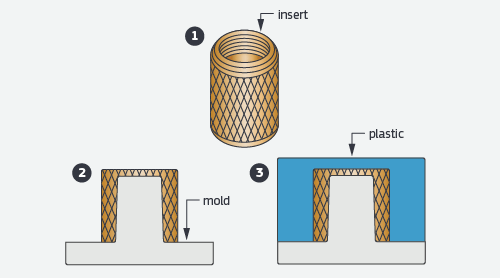
Overmolding and Insert Molding
Get custom plastic parts molded with two materials or metal inserts. Upload a part to get an online quote.
Certifications ISO 9001:2015 | ISO 13485 | CTQ Inspections | ITAR
Our overmolding and insert molding processes produce custom prototypes and on-demand production parts in as fast as 15 days. We use aluminum molds that offer cost-efficient tooling, producing parts from a range of thermoplastic and liquid silicone rubber materials.
Overmolding and insert molding are frequently used for:
- low-volume production parts
- bridge tooling
- pilot runs
- functional prototyping and testing
Overmolding and Insert Molding Design Guidelines
Our basic guidelines for overmolding and insert molding include important design considerations to help improve part manufacturability, enhance cosmetic appearance, and reduce overall production time. View our design guidelines page for more in-depth details.
| US | Metric | ||
| Maximum Part Size | 18.9 in. x 29.6 in. x 8 in. | 480mm x 751.8mm x 203.2mm | |
| Volume | 59 cu. in. | 966,837 cu. mm | |
| Depth | 4 in. from parting line | 101mm from parting line | |
| up to 8 in. if the parting line can pass through middle of part | Up to 203.2mm if the parting line can pass through middle of part | ||
| Projected Mold Area | 175 sq in. (plastic) | 112,903 sq. mm (plastic) | |
| 48 sq. in. (silicone rubber) | 30,958 sq. mm (silicone rubber) |

Additional Notes
- Height may be limited if using a silicone as the overmold material, and deeper parts are limited to a smaller outline.
- Minimum part volume is 0.025 cu. in. (40.98 cu. mm).
- With substrate molds, we can maintain a machining tolerance of ±0.003 in. (0.08mm) with an included resin tolerance that can be greater but no less than 0.002 in./in. (0.002mm/mm).
- With thermoplastic overmolds, tolerances remain the same as substrate molds, however, if the overmold is LSR, then tolerances shift to 0.025 in./in. (0.025mm).

Overmolding Material Bonding
Chemical bonding between overmolded materials is possible, but material compatibility should be considered in order to achieve desired bond strength. Incorporation of an adequate mechanical bond is strongly recommended if bonding is critical to your application. An undercut is a good example of a mechanical bond.
| Substrate Material | ||||||
|---|---|---|---|---|---|---|
| Overmold Material | ABS | ABS/PC CYCOLOY C2950-111 | PC Lexan 940-701 |
PBT Valox 357-1001 |
PP Profax 6323 | |
| TPU - Texin 983-000000 |
C | C | C | C | M | |
| TPV - Santoprene 101-87 |
M | M | M | M | C | |
| TPE - Santoprene 101-64 |
M | M | M | M | C | |
| LSR - Elastosil 3003/30 A/B |
- | - | M | M | - | |
| TPC - Hytrel 3078 | C | C | C | C | M | |
| TPE-Versaflex OM 1060X-1 |
C | C | C | M | M | |
| TPE-Versaflex OM 6240-1 |
M | M | M | M | M | |
| TPE-Versaflex OM 6258-1 |
M | M | M | M | M | |
| TPE-Versaflex OM 1040X-1 |
C | C | C | M | M | |
M = mechanical bond (recommended)
C = chemical bond
Instead of a mold that produces a final part using two separate shots like overmolding, insert molding generally consists of a preformed part—often metal—that is loaded into a mold, where it is then overmolded with plastic to create a part with improved functional or mechanical properties. We currently accept inserts from PEM, Dodge, Tri-Star, Spirol, and Tappex. A complete chart of stocked inserts at Protolabs is available here.
One way insert molding is used is with threaded inserts, which reinforce the mechanical properties of plastic parts’ ability to be fastened together, especially over repeated assembly. Bushings and sleeves are another great way to increase part durability for mating components that need more abrasion resistance due to moving parts.

What is Overmolding?
With overmolding, the production of the substrate parts is a standard injection molding process involving an aluminum mold with no heating or cooling lines running through it. Cycle times are a bit longer, which allows our molders to monitor fill pressure, cosmetic concerns, and the basic quality of the parts. When the total run of substrate parts are molded, overmold tooling is then assembled to the press. The substrate parts are placed by hand into mold where each part is overmolded with either a thermoplastic or liquid silicone rubber material.
What is Insert Molding?
Insert molding is a similar process but instead uses a preformed part—often metal—that is loaded into a mold where it is then overmolded with a thermoplastic resin to create a final component. When the run is complete, parts are boxed and shipped shortly thereafter.











